AMD Radeon HD 7970 GHz Edition Review: Battling For The Performance Crown
by Ryan Smith on June 22, 2012 12:01 AM EST- Posted in
- GPUs
- AMD
- GCN
- Radeon HD 7000
Power, Temperature, & Noise
As always, we’re wrapping up our look at a video card’s stock performance with a look at power, temperature, and noise. Officially AMD is holding the 7970GE’s TDP and PowerTune limits at the same level they were at for the 7970 – 250W – however unofficially because of the higher voltages, higher clockspeeds, and Digital Temperature Estimation eating into the remaining power headroom, we’re expecting power usage to increase. The question then is “how much?”
| Radeon HD 7970 Series Voltages | ||||
| Ref 7970GE Base Voltage | Ref 7970GE Boost Voltage | Ref 7970 Base Voltage | ||
| 1.162v | 1.218 | 1.175v | ||
Because of chip-to-chip variation, the load voltage of 7970 cards varies with the chip and how leaky it is. Short of a large sample size there’s no way to tell what the voltage of an average 7970 or 7970GE is, so we can only look at what we have.
Unlike the 7970, the 7970GE has two distinct voltages: a voltage for its base clock, and a higher voltage for its boost clock. For our 7970GE sample the base clock voltage is 1.162v, which is 0.013v lower than our reference 7970’s base clock voltage (load voltage). On the other hand our 7970GE’s boost clock voltage is 1.218, which is 0.056v higher than its base clock voltage and 0.043v higher than our reference 7970’s load voltage. In practice this means that even with chip-to-chip variation, we’d expect the 7970GE to consume a bit more power than the reference 7970 when it can boost, but equal to (or less) than the 7970 when it’s stuck at its base clock.
So how does this play out for power, temperature, and noise? Let’s find out.
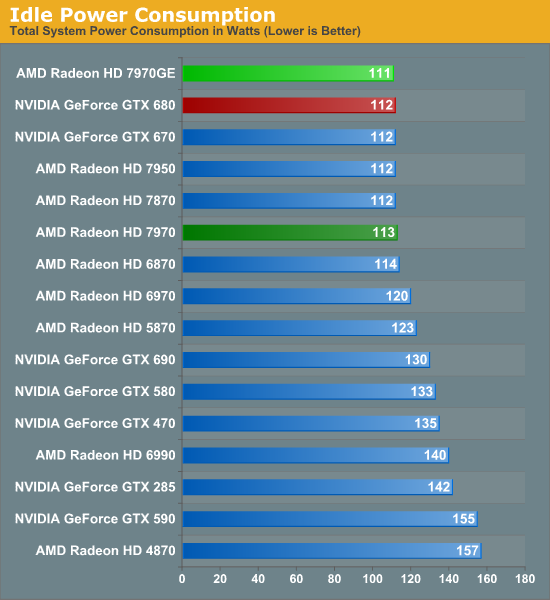
Starting with idle power, because it’s the same GPU on the same board there are no surprises here. Idle power consumption is actually down by 2W at the wall, but in practice this is such a small difference that it is almost impossible to separate from other sources. Though we wouldn’t be surprised if improving TSMC yields combined with AMD’s binning meant that real power consumption has actually decreased a hair.

Similar to idle, long idle power consumption is also slightly down. NVIDIA doesn’t have anything to rival AMD’s ZeroCore Power technology, so the 7970CE is drawing a full 10W less at the wall, a difference that will become more pronounced when we compare SLI and CF in the future.
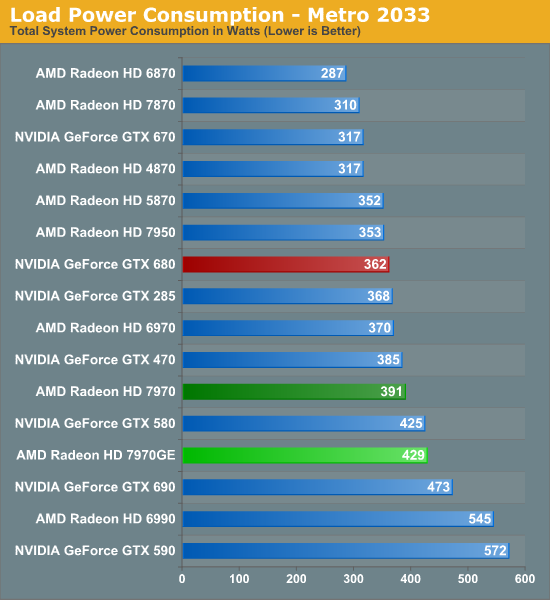
Moving on to our load power we finally see our first 7970GE power results, and while it’s not terrible it’s not great either. Power at the wall has definitely increased, with our testbed pulling 429W with the 7970GE versus 391 with the 7970. Now not all of this is due to the GPU – a certain percentage is the CPU getting to sleep less often because it needs to prepare more frames for the faster GPU – but in practice most of the difference is consumed (and exhausted) by the GPU. So the fact that the 7970GE is drawing 67W more than the GTX 680 at the wall is not insignificant.
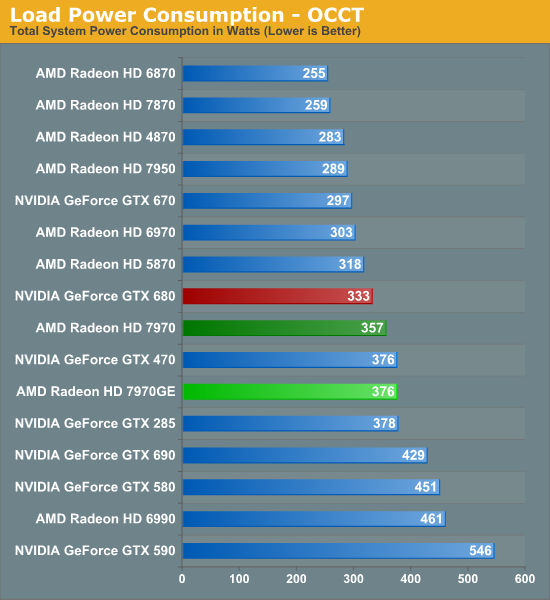
For a change of perspective we shift over to OCCT, which is our standard pathological workload and almost entirely GPU-driven. Compared to Metro, the power consumption increase from the 7970 to the 7970GE isn’t as great, but it’s definitely still there. Power has increased by 19W at the wall, which is actually more than we would have expected given the fact that the two have the same PowerTune limit and the fact that PowerTune should be heavily throttling both cards. Consequently this means that the 7970GE creates an even wider gap between the GTX 680 and AMD’s top card, with the 7970GE pulling 43W more at the wall.
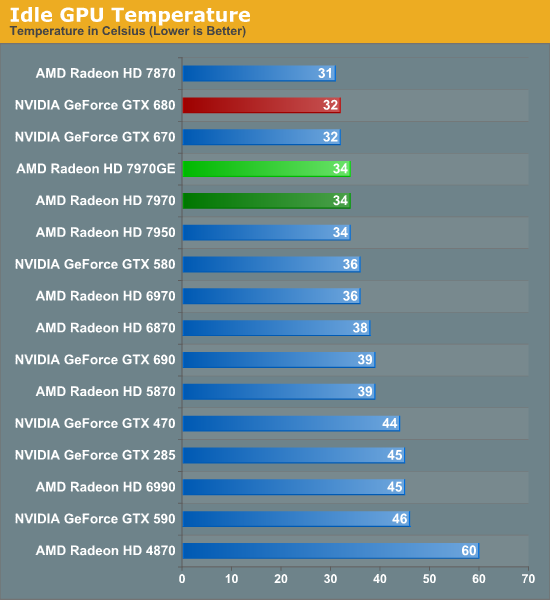
Moving on to temperatures, we don’t see a major change here. Identical hardware begets identical idle temperatures, which for the 7970GE means a cool 34C. Though the GTX 680 is a smidge cooler at 32C.
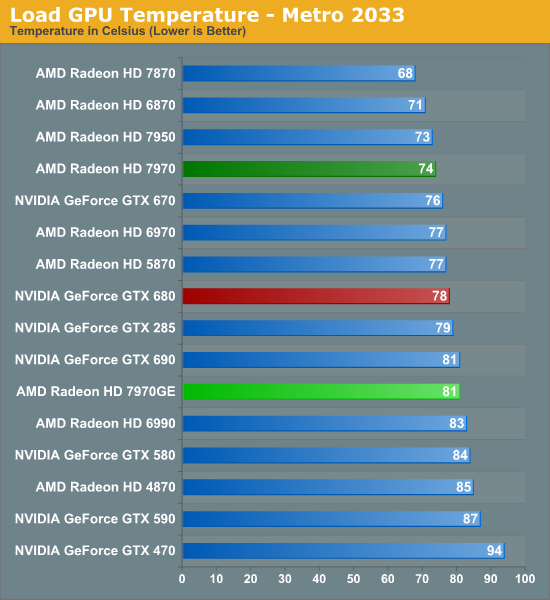
Since we’ve already seen that GPU power consumption has increased under Metro, we would expect temperatures to also increase under Metro and that’s exactly what’s happened. And actually, temperatures have increased by quite a lot, from 74C on the 7970 to 81C on the 7970GE. Since both 7970 cards share the same cooler, the 7970GE has to work harder to dissipate that extra power the card consumes, and even then temperatures will still increase some. 81C is still rather typical for a high end card, but it means there’s less thermal headroom to play with when overclocking when compared to the 7970. Furthermore it means the 7970GE is now warmer than the GTX 680.
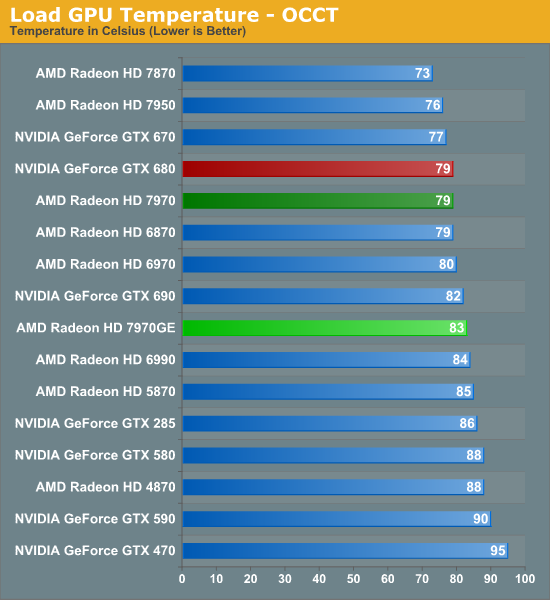
Thanks to PowerTune throttling the 7970GE doesn’t increase in temperature by nearly as much under OCCT as it does Metro, but we still see a 4C rise, pushing the 7970GE to 83C. Again this is rather normal for a high-end card, but it’s a sign of what AMD had to sacrifice to reach this level of gaming performance.
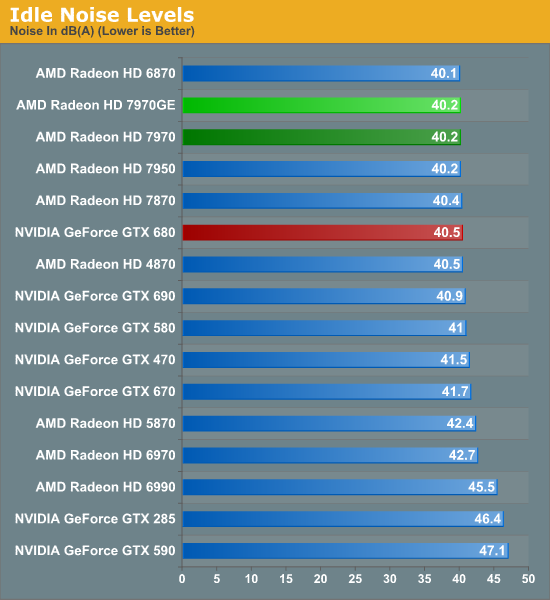
Last but not least we have our look at noise. Again with the same hardware we see no shift in idle noise, with the 7970GE registering at a quiet 40.2dBA.
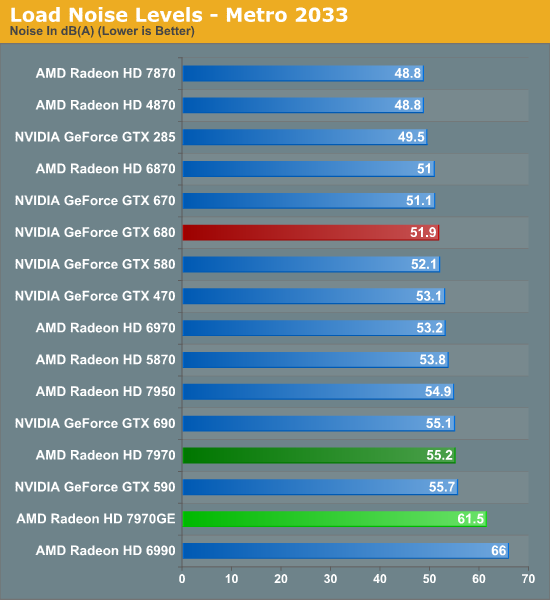
Unfortunately for AMD, this is where the 7970GE starts to come off of the rails. It’s not just power consumption and temperatures that have increased for the 7970GE, but load noise too. And it’s by quite a lot. 61.5dBA is without question loud for a video card. In fact the only card in our GPU 12 database that’s louder is the Radeon HD 6990, a dual-GPU card that was notoriously loud. The fact of the matter is that the 7970GE is significantly louder than any other card in our benchmark suite, and in all likelihood the only card that could surpass it would be the GTX 480. As a result the 7970GE isn’t only loud but it’s in a category of its own, exceeding the GTX 680 by nearly 10dBA! Even the vanilla 7970 is 6.3dBA quieter.
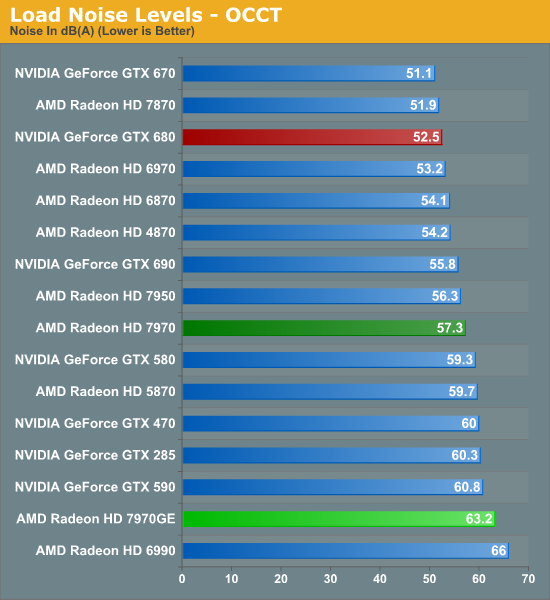
Does OCCT end up looking any better? Unfortunately the answer is no. At 63.2dBA it’s still the loudest single-GPU card in our benchmark suite by nearly 3dBA, and far, far louder than either the GTX 680 or the 7970. We’re looking at a 10.7dBA gap between the 7970GE and the GTX 680, and a still sizable 5.9dBA gap between the 7970GE and 7970.
From these results it’s clear where AMD has had to make sacrifices to achieve performance that could rival the GTX 680. By using the same card and cooler and at the same time letting power consumption increase to feed that speed, they have boxed themselves into a very ugly situation where the only solution is to run their cooler fast and to run it loud. Maybe, maybe with a better cooler they could have kept noise levels similar to the 7970 (which would have meant it would still be louder than the GTX 680), but that’s not what we’re looking at.
The 7970GE is without question the loudest single-GPU video card we have seen in quite some time, and that’s nothing for AMD to be proud of. Everyone’s limit for noise differs, but when we’re talking about single-GPU cards exceeding 60dB in Metro we have to seriously ponder whether it’s something many gamers would be willing to put up with.










110 Comments
View All Comments
Belard - Friday, June 22, 2012 - link
Agreed.Articuno - Friday, June 22, 2012 - link
A whole new card launch and yet another pair of similarly named but differently performing products because they changed a few numbers that anyone can in several free, easily available programs.I suppose they can do this because you can actually buy their products though, unlike the 6XX series.
ExarKun333 - Friday, June 22, 2012 - link
Yeah, tough to find 6xx products indeed. There is something called the 'internet' you could check out. Your buddy who posted for you might be able to help you out. ;)Pantsu - Friday, June 22, 2012 - link
I doubt any AIB will actually release GE cards with reference cooling. Most likely they will be custom cooled, so the loudness of the reference card is a bit of a moot point.It's good to see some decent driver improvements from AMD. I'm still quite happy about 7970 performance at 5760x1080, and it's enough for most games when OC'd. It would be interesting to see though, whether the GE has improved the max OC. Most likely it's no better though, and you'll be better off buying an old custom 7970 for a good price and OC'ing it to the same levels as the GE.
dagamer34 - Friday, June 22, 2012 - link
The GE chips are better binned parts, one would assume that they have a bit more room for higher clocks than the normal 7970 parts. Certainly the average overclock will be higher.CeriseCogburn - Saturday, June 23, 2012 - link
So we can deduce that the prior 7970 overclocks were sucking down an even larger amount of enormous electrical power as those chips are of lower bin.I guess we need an overclocked power suction chart with an extended table for the amd housefire 7970.
Any savings on card price or a few frames at a resolution near no one owns will be gobbled up by your electric bill every month for years - save 1 watt or 9 watts at extended idle, but when you game it's 100+ watts and beyond with the overclocked 7970 - maybe they should be $300 with 3 games.
silverblue - Monday, June 25, 2012 - link
Well, it works both ways. You won't always be gaming, in addition there's all that compute hardware that, if properly harnessed, would save you money over competing solutions because you'd get the job done quicker. It used to be pointless to consider using anything for compute that wasn't a Quadro, Tesla or even FirePro, however those days are coming to an end.Having a 7970 will make sense for compute if that's your bag (there's a reason for the die size plus the extra memory and bus width), but this time, NVIDIA enjoys a performance/watt advantage which might go unchallenged for a while. Unless, of course, that extra hardware on the 7970 is properly leveraged; future games, perhaps?
ltcommanderdata - Friday, June 22, 2012 - link
So do we think this will encourage nVidia to release a GeForce GK110 based product in the next few months rather than restrict it to Tesla?PsiAmp - Friday, June 22, 2012 - link
Nvidia isn't holding GK110 in its sleeve waiting for something. It is unfinished in the first place and there's no manufacturing capacity to produce such a large chip. Nvidia still struggles to fix GK104 design to have good yields. GK110 would be impossible to produce in since it is twice bigger and such will have at least 4 times less yield.Server market is not only much more profitable, it is operating on a contract basis. Nvidia will start to produce Tesla K20 in Q4 2012.
IF(?) desktop card based on GK110 will hit the market it won't be sooner than Q1 2013. And it is not something that you can change really.
silverblue - Friday, June 22, 2012 - link
"Of course this isn’t the first time we’ve had a hot & loud card on our hands – historically it happens to NVIDIA a lot – but when NVIDIA gets hot & loud they bring the performance necessary to match it. Such was the case with the GTX 480, a notably loud card that also had a 15% performance advantage on AMD’s flagship. AMD has no such performance advantage here, and that makes the 7970GE’s power consumption and noise much harder to justify even with a “performance at any cost” philosophy."Very true, however the power consumption and heat difference between the 5870 and the 480 was definitely more pronounced.
The 680 is an incredible card, no doubt about it. It may not win in some titles, but it's hardly anywhere near unplayable either. AMD being right there at the very high end is fantastic but unless titles truly make use of GCN's compute ability, the extra power and noise are going to be hard to swallow. Still, I'd own either. :P